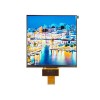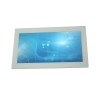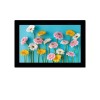Products
Hot Product
1.3 inch132*32 STN Monochrome Display ST7560 Controller
Size: 1.3 inch
Dimension: 34.5*15*1.75mm
Resolution:132*32
Driver: ST7560
Connector:soldering/utra
Display effect: yellow green light black words
Display model: STN
Product Details
Is monochrome display good for eyes?
Monochrome displays, which typically show content in shades of a single color (often black and white or green and black), have several characteristics that can potentially be beneficial for eye comfort and health:
1. Reduced blue light emission: Many modern color displays emit significant amounts of blue light, which has been associated with eye strain and disruption of circadian rhythms. Monochrome displays, especially those using e-ink technology, often emit less blue light, potentially reducing eye fatigue and sleep disturbances.
2. High contrast: Monochrome displays frequently offer excellent contrast ratios, particularly black and white displays. This high contrast can make text and images easier to discern, potentially reducing eye strain during extended reading or viewing sessions.
3. Reduced color-related eye strain: Some individuals experience eye strain or headaches from prolonged exposure to vibrant colors on digital screens. Monochrome displays eliminate this issue by presenting information in a single color spectrum.
4. Simplified visual processing: With fewer colors to process, the brain may experience less visual fatigue when interpreting information on a monochrome display, especially during long reading sessions.
5. Reduced flicker: Some older monochrome displays, particularly CRT monitors, had higher refresh rates than their color counterparts, resulting in less visible flicker. This can contribute to reduced eye strain, although modern LCD and LED displays have largely mitigated this issue.
However, it's important to note that the impact of monochrome displays on eye health is not universally positive and can vary depending on several factors:
1. Lighting conditions: The benefits of monochrome displays may be more pronounced in low-light environments, where the reduced brightness and absence of multiple colors can be less jarring to the eyes.
2. Display technology: The specific technology used in the monochrome display (e.g., e-ink, LCD, OLED) can significantly affect its impact on eye comfort.
3. Individual sensitivity: Some people may find monochrome displays more comfortable, while others may prefer color displays or experience no significant difference.
4. Content type: For certain types of content, such as complex images or data visualizations, color displays may actually be easier on the eyes by allowing for better differentiation of information.
5. Brightness and contrast settings: Regardless of whether a display is monochrome or color, proper adjustment of brightness and contrast is crucial for eye comfort.
6. Viewing distance and duration: The distance from which you view the display and the length of time spent looking at it are important factors in eye strain, regardless of whether the display is monochrome or color.
It's worth noting that while monochrome displays may offer some benefits for eye comfort, they are not inherently superior to all color displays in this regard. Modern color displays with features like blue light filters, high refresh rates, and adjustable color temperatures can also be very comfortable for extended use.
To maximize eye comfort when using any type of display, consider the following recommendations:
1. Follow the 20-20-20 rule: Every 20 minutes, take a 20-second break to look at something 20 feet away.
2. Ensure proper lighting in your environment to reduce glare and contrast issues.
3. Adjust display settings (brightness, contrast, text size) to suit your comfort level and ambient lighting conditions.
4. Position your display at an appropriate distance and angle to minimize neck strain and optimize viewing comfort.
5. Use anti-glare filters or glasses if you're particularly sensitive to screen glare.
6. Consider using software tools that adjust display color temperature based on the time of day to reduce blue light exposure in the evening.
In conclusion, while monochrome displays can offer some potential benefits for eye comfort, the overall impact on eye health depends on various factors. It's essential to consider your individual needs, the specific display technology, and proper usage habits to maintain optimal eye health when using any type of digital display.
Inquiry Now
Can't find the specific information you’re looking for? Have a question ? Contact Us













